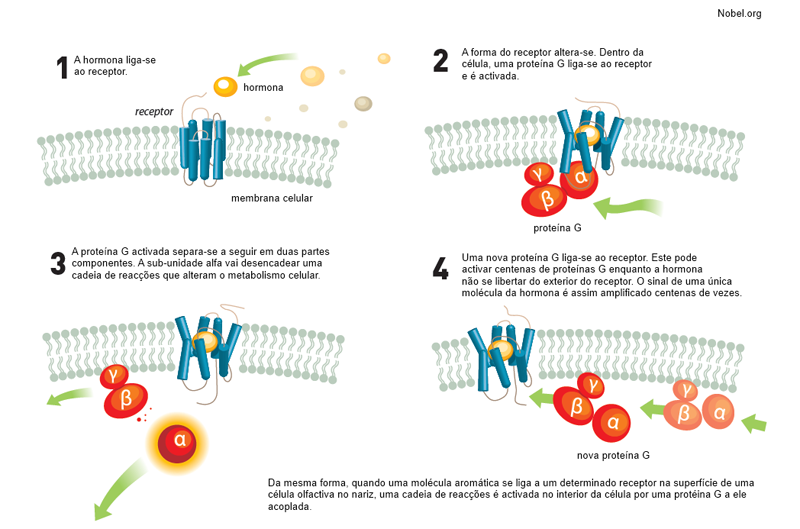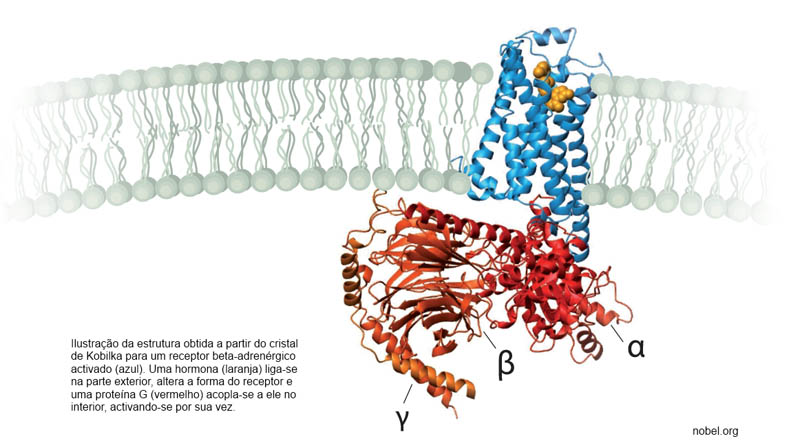 Two Americans, Robert Lefkowitz and Brian Kobilka, were awarded the 2012 Nobel Prize in Chemistry for their studies on “G protein-coupled receptors”, a “a work of molecular art resulting from decades of research”, announced the Royal Swedish Academy of Sciences.
Two Americans, Robert Lefkowitz and Brian Kobilka, were awarded the 2012 Nobel Prize in Chemistry for their studies on “G protein-coupled receptors”, a “a work of molecular art resulting from decades of research”, announced the Royal Swedish Academy of Sciences.
In our eyes, nose, mouth, ear, in our skin cells there are sensors for light, aromas, flavors, sounds, and touch, respectively, which allow us to feel the world around us.
Inside our body, all cells have sensors, which were found to be similar to these, and which allow cells to "feel" hormones and signaling substances, "hear", "perceive" and react in accordance with the words of authentic intracellular communication biochemical language that is the antechamber of physiological functioning that allows all the organs and tissues of our body to function in harmony, react to disease, adapt to the circumstance of a luminous gaze, a maternal aroma, a taste of our childhood, of a familiar hand, of a passionate whisper.
It is through these sensors, which are proteins, on the surface of cell membranes, like receptor antennas peering into the extracellular environment, and a family of other proteins coupled to them, called G proteins, located on the inner face of the membrane, at the interface between the exterior and the cascade of metabolic processes, which translate the message into structural and functional action, that life makes itself. They are the translators of the various biochemical scores that govern other biomolecules of the cellular orchestra. The result is the beautiful symphony of life.
It was the characterization of the structure and functioning of these biochemical signal transduction mechanisms that has now been recognized by the Royal Swedish Academy.
The award of the Nobel Prize for Chemistry to the Americans Robert Lefkowitz and Brian Kobilka rewards decades of research that allow us today to “see” hormones such as adrenaline, histamine and insulin, or neurotransmitters such as serotonin, at work at the molecular level or dopamine.
Lefkowitz, in 1968, managed to identify a receptor sensitive to adrenaline in the cell membrane. Then, in the 1980s, Kobilka, working on Lefkowitz's team, managed to isolate the gene that encodes this receptor, a very arduous task for the time, when the rapid gene sequencing methods that are now almost common in laboratories of genetics.
This receptor, a protein called beta-adrenergic, is now the basis of beta-blocker drugs, which are widely used to treat heart disease.
By analyzing the sequenced gene, the scientists found that the protein it encoded was similar to another receptor, rhodopsin, found in the eye and which is involved in the perception of light. That was the “true eureka moment”, according to Lefkowitz, in a statement cited by the Nobel Committee.
Both receptors interacted with a G protein inside the cell and another 30 receptors were known to function in the same way. It continued that this mechanism would have to be very universal in the cellular context. Today, about a thousand genes are known to encode this type of receptor.
In 2011, Kobilka and his own team managed, through X-ray diffraction crystallography (generally the same method that resolved the double helix structure of DNA), to “photograph” an image of the beta-adrenergic receptor at the instant that it is activated by a hormone and sends a signal inside the cell. “A molecular masterpiece — the result of a decade of research”, underlines the Nobel Committee.
This allows us to better understand how organs such as the brain, glands, heart, stomach, among others, communicate with each other. How does the perception of danger or the feeling of fear translate into releasing enough adrenaline into the bloodstream for the heart to increase its beating frequency, blood pressure to increase, and so we can react, running or fighting more effectively to safeguard survival. The unregulated reverse, in the same mechanisms, causes diseases such as hypertension.
Understanding the structures and receptors and the G proteins attached to them, as well as their functioning, proved to be very important for the understanding at the molecular level of the physiological processes involved in the maintenance of health status and for the development of new drugs for treat diseases. In fact, about 50% of existing drugs work through them, because many diseases result from disturbances at the molecular level in which they are involved.
Author Antonio Piedade
Science in the Regional Press – Ciência Viva
See the two infographics:




















Comments